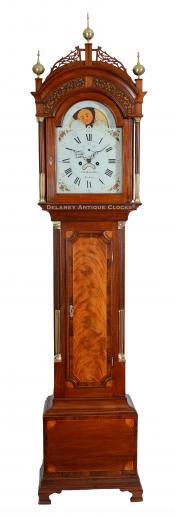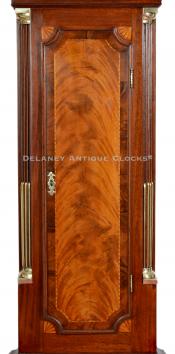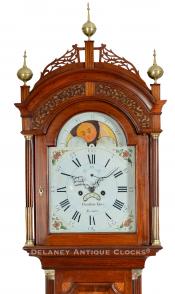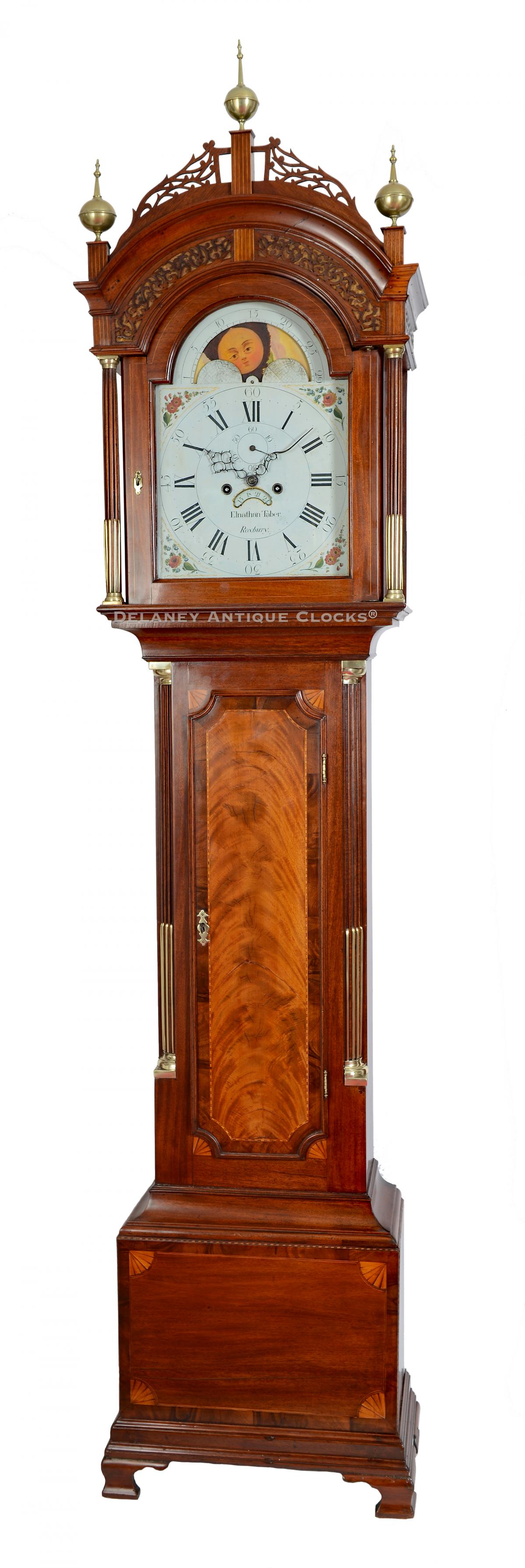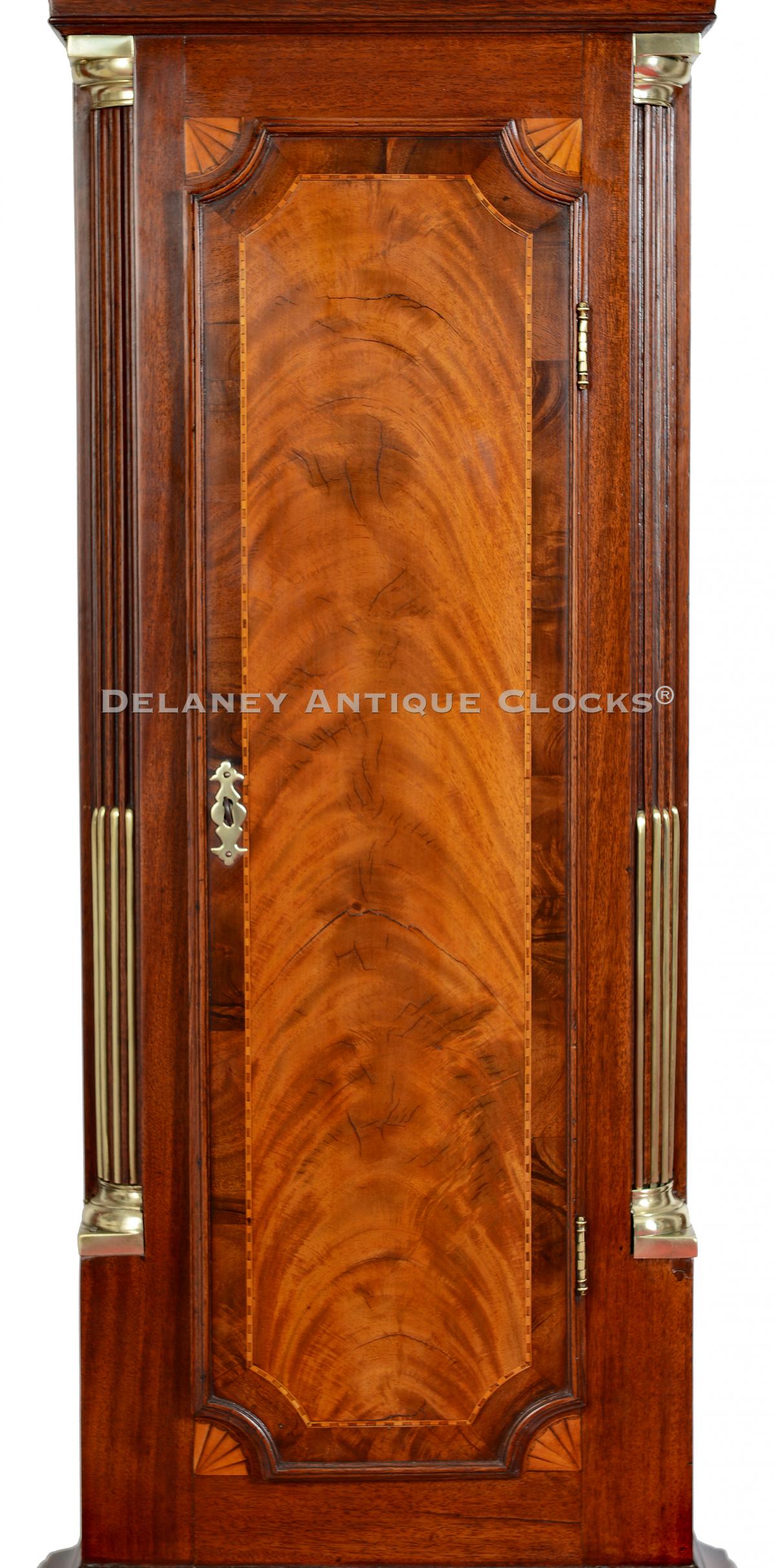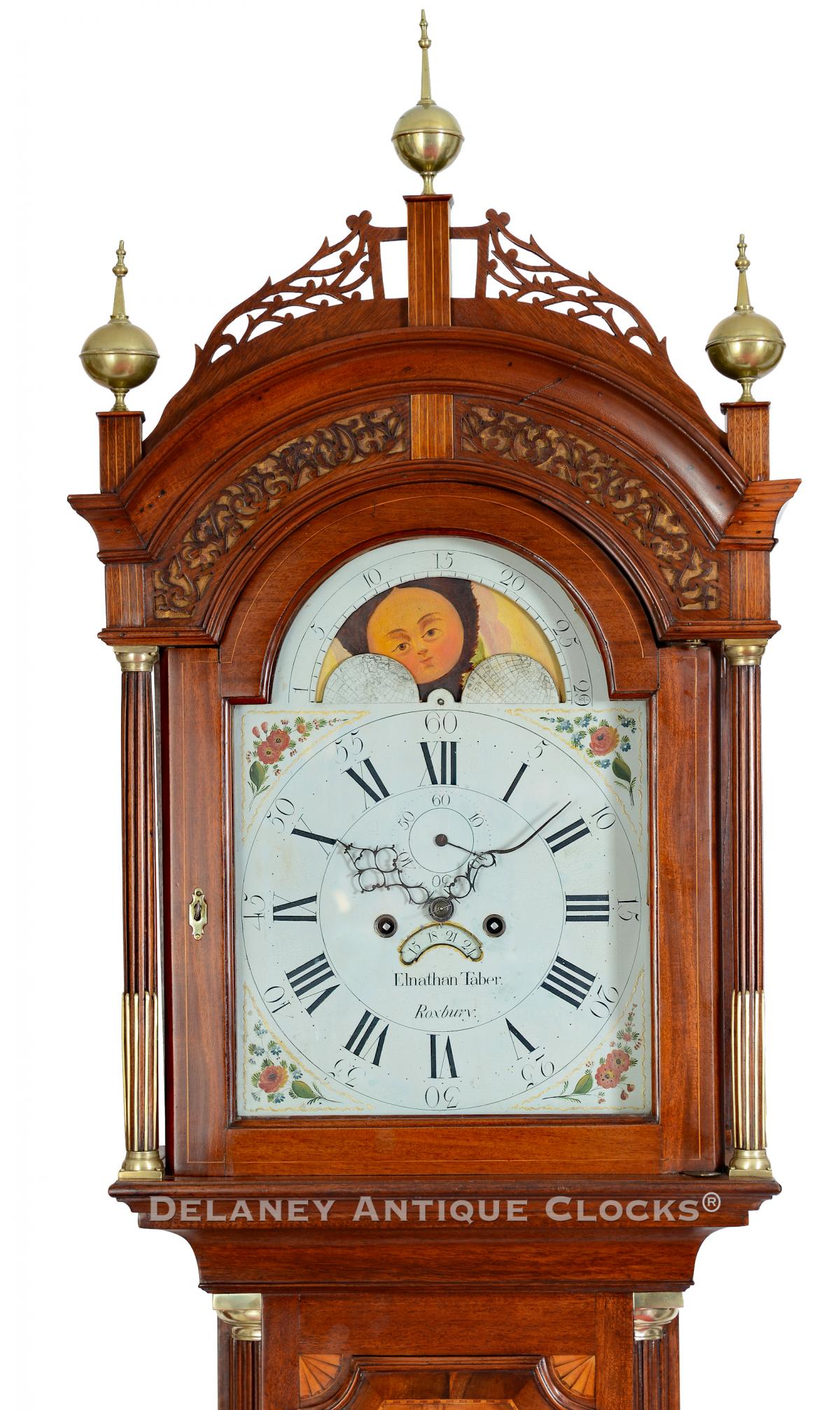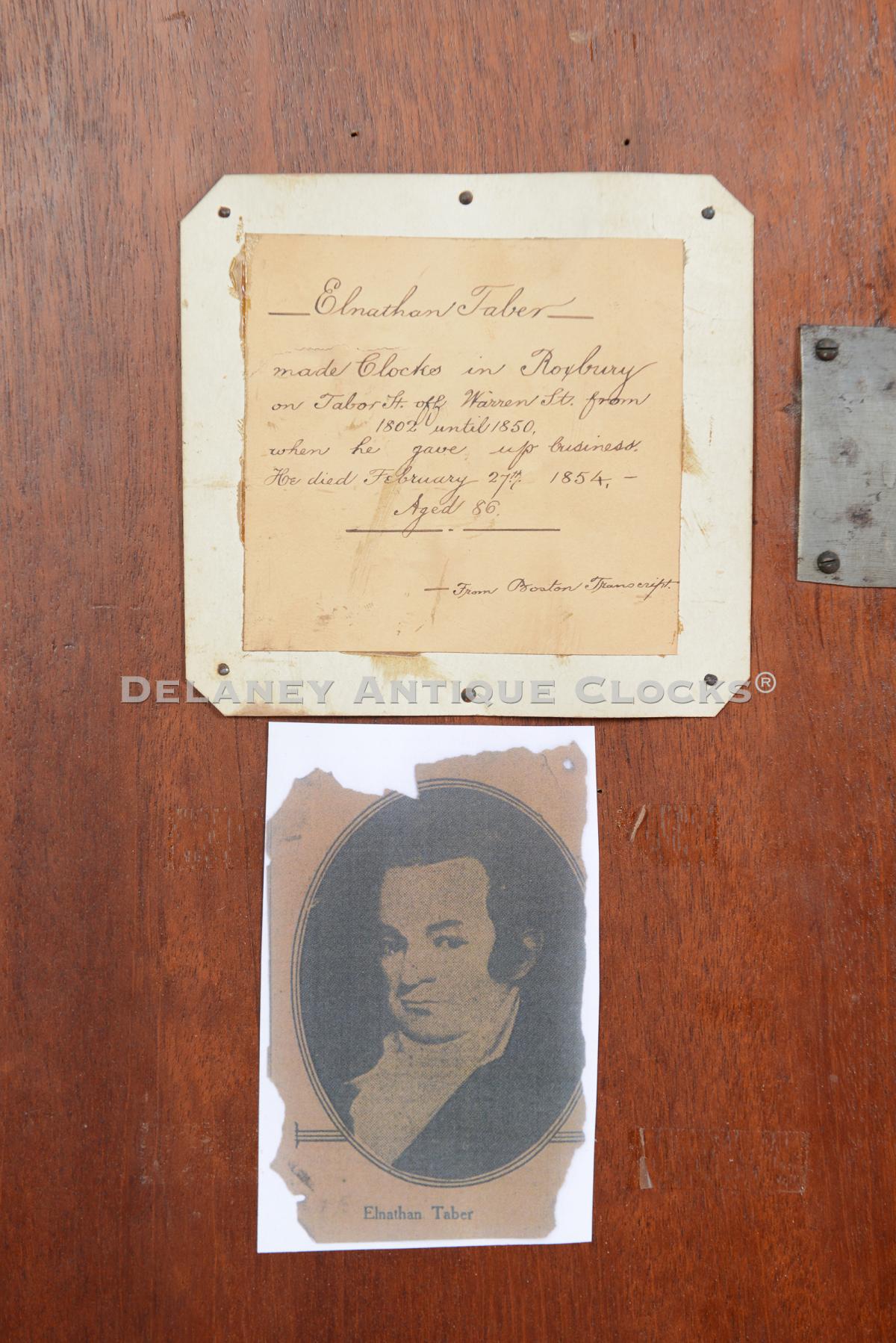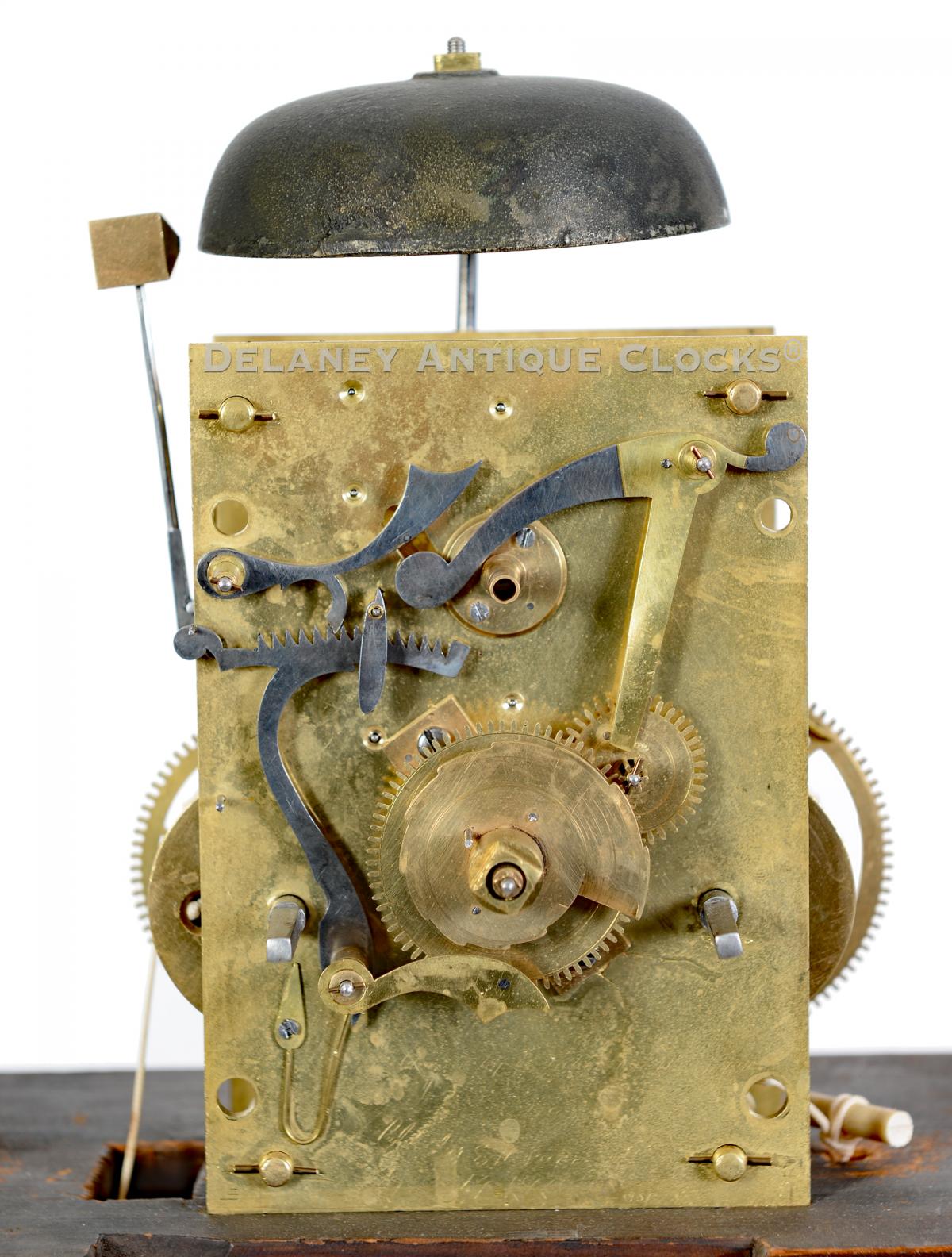An outstanding inlaid mahogany tall case clock made by Elnathan Taber Roxbury, Massachusetts. The cabinet was made in Stephen Badlam's workshop. 223209.
This extravagant inlaid mahogany case is attributed to Stephen Badlam (1751-1815) of Dorchester Lower Mills, Massachusetts. Badlam was the proprietor of a cabinet shop that made cases for the Willards and other Roxbury clockmakers. Fortunately, several of these cases are identified by Badlam's occasional practice of stamping his initials or the initials of one of his apprentices inside the case. The Willard House and Clock Museum, located in North Grafton, Massachusetts, has three clocks of this general type in its collection. These are illustrated in "THE WILLARD HOUSE AND CLOCK MUSEUM and The Willard Family Clockmakers," written by Dr. Roger Robinson & Herschel Burt. The most impressive example houses a musical set of works constructed by Simon Willard. A second signed example features a painted dial signed by Aaron Willard.
Stephen Badlam was born on May 7, 1751, in Stoughton, now Canton, MA, the son of Deacon Stephen Badlam and his wife Hannah (Clapp) Badlam. After a very difficult childhood, at age 15, Stephen moved to Dorchester to live and work with his older brother Ezra (born May 19, 1746 – died 1788). There, he learned the cabinetmaker's trade from his brother. By 1773, the two brothers had formed a partnership and settled in the Lower Mills section of that town. Soon, the Revolution came a calling. Stephen answered the Lexington Alarm as a sergeant and served in Captain Daniel Vose's train band company. His rise in the ranks was rapid; by July of the same year, he was promoted to the rank of captain. Stephen served in the military for several years. In 1799, he was named a Brigadier General in Gen. Eliot's division. After the war, Stephen resumed his cabinetmaking career. He died in 1815.
This case stands on boldly formed ogee bracket feet applied to the double-stepped molding mounted to the bottom of the base. The base panel features an intricate inlay design, including barber pole line inlay, cross-banding, inlaid quarter fans, and figured veneers. Much of this design is repeated in the waist section in the construction of the waist door. The crotch veneer pattern selected for this featured location is vibrant. The corners of the door and the applied molding that frames the door are cut away. The inlaid quarter fans are part of the door frame, not the door. This decorative feature appears to be unique to the Badlam shop. Through this door, one can access the weights and pendulum. The sides of this case are fitted with brass stop-fluted quarter columns. These terminate in brass quarter capitals. The bonnet features a double-break arch design. The arches are separated by two sections of intricately designed blind frets. These are located in the tampyium and are backed in silk. Vertically lined inlaid blocks border them. The top of the upper arch supports a pierced and open fretwork pattern that includes line inlaid finial plinths. These are fitted with three ball-and-spike brass finials. The bonnet columns are also brass, stop-fluted, and terminate in brass capitals. The bonnet door is an arched form. This door opens to access the colorfully painted iron dial.
The very colorful 13-inch painted iron dial was painted in Boston by Spencer Nolen and is prominently signed "Elnathan Taber/ Roxbury." The location of the signature is positioned just below the month calendar aperture. Above this is a subsidiary seconds dial. The time ring is formatted with large Roman-style hour numerals, a dotted minute ring, and Arabic five-minute makers. The four spandrel areas are decorated with floral themes. The framing is defined with raised patterns finished in gilt paint. One will find a moon phase mechanism or lunar calendar in the arch of this dial. The lunar calendar or moon phase mechanism is a mechanical almanac. This feature was most likely made on special order due to the extra work involved in producing it. This display would have been valuable to several occupations during the colonial era. Farmers were known to track the moon phase to anticipate the days that offered the most available moonlight. A bright night would be more beneficial to them in scheduling the tilling and harvesting of their fields. Sailors and merchants track the lunar phases to know when the high tide would allow their ships to sail easily from the harbor or when the fishing might be best. Numerous religious groups had an almost superstitious litany of rituals that were best performed in accordance with lunar events. The actual lunar month represents an inconvenient interval of 29 days, 12 hours, 44 minutes, and 2.8 seconds. A tall clock's lunar calendar is set constant at 29.5 days, which represents a complete cycle. As a result, a 9-hour setback is required at the end of a single year to keep the lunar display current.
The clock movement is constructed in brass and is of good quality. Four-turned pillars support the two large brass plates. Hardened steel shafts support the polished steel pinions and brass gearing. The winding drums are grooved. The escapement is designed in a recoil format. The movement is weight-driven and designed to run for eight days fully wound. It is a two-train or a time-and-strike design, having a rack and snail striking system. As a result, it will strike each hour on the hour. This is done on a cast iron bell mounted above the movement.
This beautifully inlaid clock was made circa 1792. It stands approximately 7 feet 10 inches tall ( 84 inches) to the top of the center finial. The case is constructed in mahogany with holly line inlays, and New England white pine is used as a secondary wood. The mahogany retains a deep, rich finish
Inventory number 223209.
Elnathan Taber was born in Dartmouth, Massachusetts, on February 14, 1768, and may have died in Dartmouth, Massachusetts, on February 27, 1854, at the age of 86. His grave was moved from Dartmouth to Forest Hills Cemetery in Jamaica Plain on October 29, 1870. His parents were Thomas and Elizabeth (Swift) Taber. Elnathan is the older brother of Stephen Taber, whose fortune helped found Taber Academy in Marion, MA. Both brothers traveled to Roxbury and were trained as clockmakers by the Willards. Elnathan was just 16. After serving his apprenticeship, Elnathan stayed and worked in Roxbury. His shop was located on Union Street. Union Street was renamed Taber Street in April 1868 in his honor. He was the first resident of that street. William Cummens also moved there and set up shop at the corner of Winslow. This short street was between Warren Street and Winslow Street. Elnathan maintained a close working relationship with his mentor Simon and became one of his most famous apprentices. He was authorized by Simon to make his patent timepieces during the patent period. He was also a prolific repairman. His name can be found engraved on numerous Boston area-made clocks as a service record. Elnathan married Catherine Partridge in January 1797. They had four children between the years of 1797 and 1811. Catherine had three sisters who also married clockmakers. Her sister Elizabeth married Abel Hutchins, and Mary (Polly) married Aaron Willard. A third sister married Samuel Curtis. Over the years, we have owned and sold numerous tall case clocks made by this fine clockmaker. In addition, we have owned a good number of wall timepieces in the form of banjo clocks and coffin clocks, as well as several of the Massachusetts shelf clock forms.

